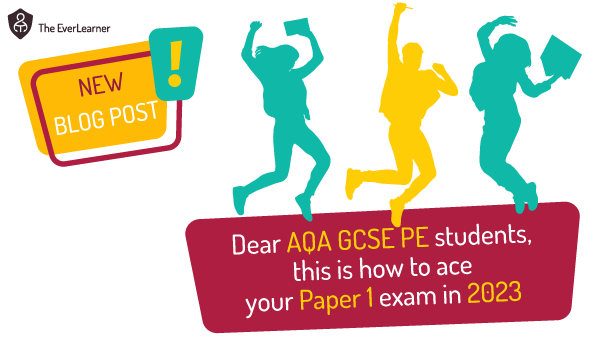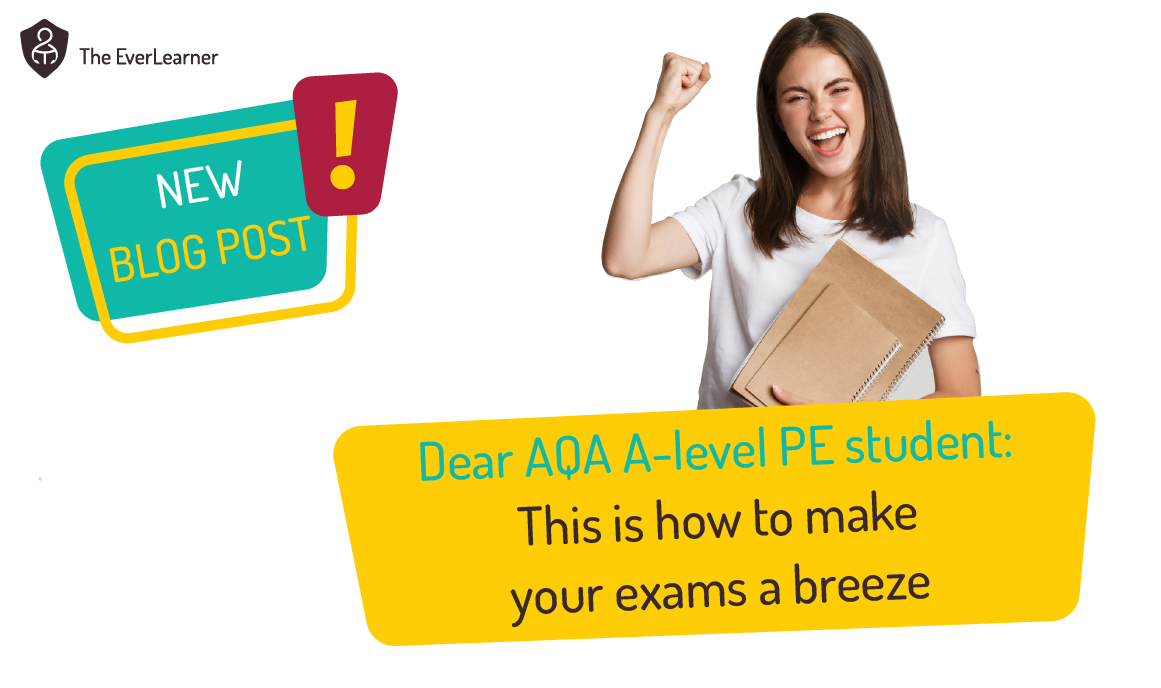Dear OCR GCSE PE students, this is how to ace your Paper 1 exam
Dear OCR GCSE PE student,
Yes, you! The one reading this post. I wanted to ask for a few moments of your time in order to share with you a few ideas about how to really prepare sharply for your Paper 1 exam.
The OCR GCSE PE paper 1 is a toughie. You know this already but, when rendered down into core elements, it’s really, really achievable.
The aim of this post is to give you 10 ideas that you can use to prepare better for your exam. Follow these guidelines as part of a thorough revision experience and I am confident you will fly.
My 10 top tips:
- Practise lots and lots of one and two-markers.
- Learn the command terms and what they mean.
- Be prepared to explain.
- Use the E-I-O method when making examples.
- Know long-term and Short-term Effects of Exercise and Planes and Axes inside out.
- Reorder the paper for maximum performance.
- Be aware of the Paper 2 topics that have appeared on Paper 1 in the past.
- Complete and mark the National Mock Exam.
- Learn my model answers.
- Attend my revision sessions in May.
Top Tip #1 Practise lots and lots of one and two-markers
Well, this one is pretty obvious. One and two-mark questions make up 36 of 60 marks on average on an OCR GCSE PE Paper 1 exam. Take a look at this graph:
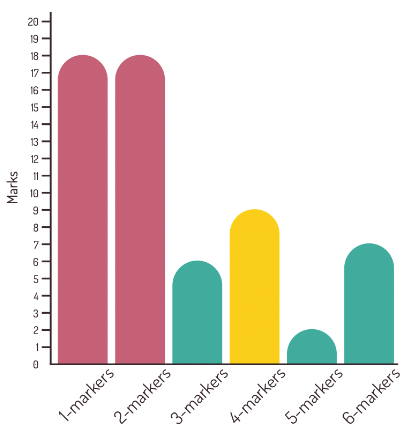 Average mark allocation for all paper 1s since 2018
Average mark allocation for all paper 1s since 2018
Therefore, there is nothing more impacting that you can do in order to prepare for your Paper 1 exam than to practise writing and marking one- and two-mark questions.
There are hundreds of examples available for you to practise on. If you do not already have access to ExamSimulator via TheEverLearner.com, speak to your teacher about this. Within this system, there are hundreds of one- and two-markers for you to engage with.
Top Tip #2 Learn the command terms and what they mean.
It is so easy to think of your exams as testing your knowledge. Well, they do, of course. But your exams (and, in this case, your OCR GCSE PE Paper 1 exam) also test your skills.
Take a look here:
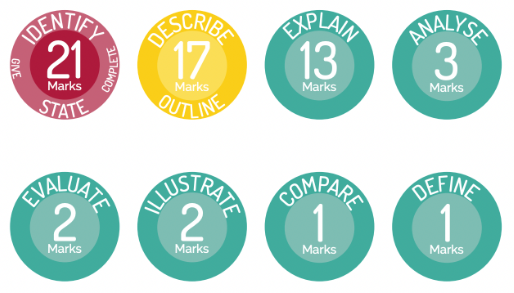 Average skill marks for all Paper 1s since 2018
Average skill marks for all Paper 1s since 2018
And here:
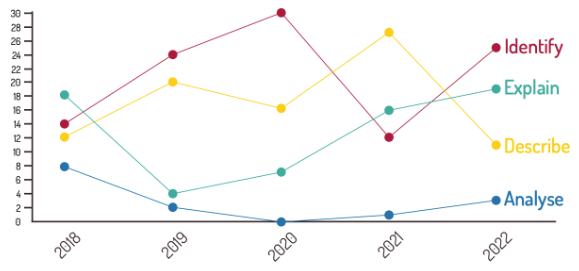 Marks awarded per skill
Marks awarded per skill
The skills that you need to perform have a degree of consistency. Identify (often for one mark) is obvious but take a look at explaining and describing. If you are able to really understand the requirements of these skills, you are going to develop an excellent advantage.
So, what do these skills actually mean? Take a look at the table below and start to think about how to respond when asked to develop each different skill. I also encourage you to highlight the skills that appear most commonly on OCR GCSE PE Paper 1 exams.
| Command term | Description | Assessment Objectives | ||
| AO1 | AO2 | AO3 | ||
| Identify | It can require a selection from a given stimulus or resource, for example, an option from a multiple choice question or analysis of data from source material such as a graph, or can be synonymous with give/state. | ✔ | ✔ | |
| State | It generally involves the recall of a fact (for example, "State one benefit of...") but it can, when used in relation to a context, be used to determine a learner's grasp of information presented. For example, a data analysis question. It can be synonymous with give/identify. | ✔ | ||
| Give | It generally involves the recall of a fact or an example based on the given stimulus. For example, "Give an example of a specific sporting movement..." It can be synonymous with identify/state. | ✔ | ||
| Define | It requires to give the meaning of a word/term. | ✔ | ||
| Describe | Give an account of something without explanation. | ✔ | ✔ | |
| Compare | Find similarities and differences. | ✔ | ✔ | |
| Explain | Requires a justification/exemplification of a point. The answer must contain some linked reasoning. For example, the format of the response may be "fact...because...therefore..." | ✔ | ✔ | |
| Justify | Give reasons for the answers. This could be a single response to extended writing answers depending on question context. for example "Justify the use of interval training to improve..." | ✔ | ||
| Discuss | Review/analyse information, bringing it together to form a conclusion/judgement based on strengths/weaknesses, alternatives, relevant data or information. Come to a supported judgement of a subject's qualities and relation to it's context. | ✔ | ✔ | ✔ |
| Analyse | Break something down into it's component parts; this could be in relation to movement analysis. | ✔ | ✔ | ✔ |
| Evaluate | Review/analyse information, bringing it together to form a conclusion/judgement based on strengths/weaknesses, alternatives, relevant data or information. Come to a supported judgement of a subject's qualities and relation to it's context. | ✔ | ✔ | ✔ |
Top Tip #3 Be prepared to explain.
As you can see above, explaining is a key skill. OCR consider this about explaining:
In other words, you need to be able to state “how?” and/or “why?” for every single topic on the course. Simply knowing a definition or being able to describe a concept will, within explain responses, not be enough.
Let’s take an example. Let’s say I get two different questions about the same topic:
Describe the author of this blog (James).
James is 46 years old, a man and publishes regularly including in his blog.
James is the author because he is an experienced teacher of academic PE and this blog is all about teaching academic PE. This means that James has ideas to share with PE students and teachers. Therefore, he writes meaningful articles with the aim of helping fellow PE teachers and PE students perform better in their PE courses.
Now, if I changed Q2 to “Explain how James blogs,” can you see how the answer would change? Do you agree that we may need to talk about my use of English, my computer, my website and even processes such as getting the articles proofread and a graphic designer making the imagery? Can you see that my answer is specific to the question posed? You need to do this.
If you are asked to explain, which you will be, you must explain! Here’s some language that you should use in your explain responses:
| Explain why... | Explain how... |
| because | through |
| this means | by |
| as a result | via |
| therefore | as a result of |
| the reason for this | caused by |
Just like you prepare for your knowledge, you need to prepare for your skills. I will take this further below.
Top Tip #4 Use the E-I-O method when making examples.
AO2 skills (otherwise known as “making examples”) is the second biggest feature of a successful OCR GCSE PE Paper 1 performance:
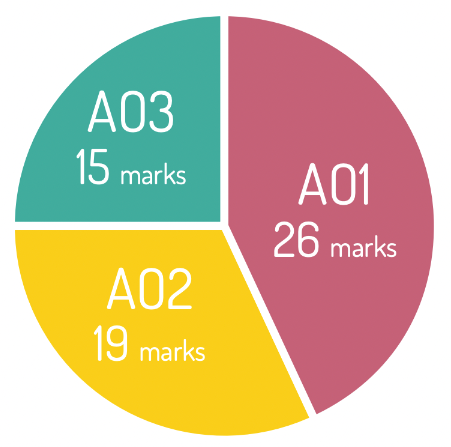 Average marks for AO coverage for all paper 1s since 2018
Average marks for AO coverage for all paper 1s since 2018
On average, 26 marks come from making examples effectively. Therefore, you need to prepare for this and I encourage you to use the E-I-O method. Thankfully this is nice and simple:
.webp?width=850&height=133&name=image13%20(1).webp)
When you make your example, you MUST state the impact and the outcome of the concept on the example. Let’s take our own example:

Our author has clearly stated what the example is (dribbling), has stated the impact of the concept/agility and has gone on to state the outcome of the concept. This is the standard I urge you to achieve when making your own examples.
Let’s look at another example from Paper 1:
.webp?width=650&height=385&name=image2%20(1).webp)
In this response, the entire answer is applied to the example using the E-I-O method.
Teachers and students wishing to study the E-I-O method in more detail should visit 100 Practical Examples Part 1, 100 Practical Examples Part 2 and 100 Practical Examples Part 3 of my writing on this topic.
Top Tip #5 Know Long-term and Short-term Effects of Exercise and Planes and Axes inside out.
How can I put this without being accused of predicting your 2023 paper? I guess the only way I can say it is that, by some margin, Short-term Effects, Long-term Effects and Planes and Axes have been the most heavily examined topics between 2018 and 2022.
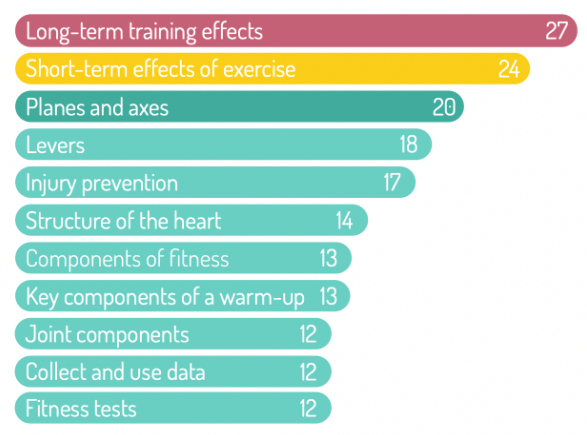 Total marks for most examined topics for all paper 1s since 2018
Total marks for most examined topics for all paper 1s since 2018
Therefore, only a fool would not have these topics absolutely nailed down in preparation for their exam in 2023.
Let’s take them in turn:

We know the following about Long-term Effects of Exercise:
- It has been examined every year so far with substantial marks available on most papers.
- Most marks from this topic come from the “describe” skill.
- Being able to explain the impact of long-term training is also critical.
So, guess what? This topic and these skills are going to be a central feature of my revision sessions (see tip 10) in May.

We know the following about short-term effects:
- The topic has appeared on almost every paper between 2018 and 2022, with substantial marks available on at least half the papers.
- The “explain” skill is critical for success in this topic.
- Almost all marks for short-term effects come from AO2 and AO3. In other words, simply knowing the short-term effects is not enough.

We know the following about planes and axes:
- Like the Long-term Effects of Exercise, Planes and Axes have featured on every paper between 2018 and 2022.
- The vast majority of marks on this topic come from AO3.
So, in summary, whilst there are no guarantees about what might appear on a 2023 exam paper, preparing for these three topics diligently and with the key skills in mind is a very good investment of your revision time.
With this in mind, I urge you to take part in my utterly free Paper 1 revision in May.
Top Tip #6 Re-order the paper for maximum performance.
Okay, this recommendation will provide you a choice but I want you to at least consider what I am suggesting.
On OCR GCSE PE Paper 1 exams, questions begin to “heat up” from question 21 onwards. Take a look at these three images and make reference to question 21 in each case.
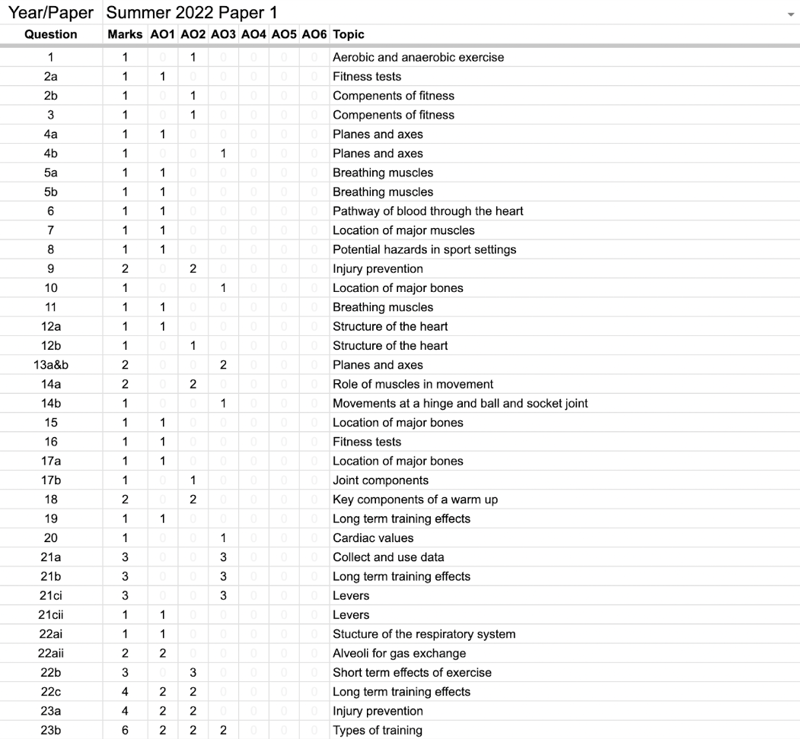
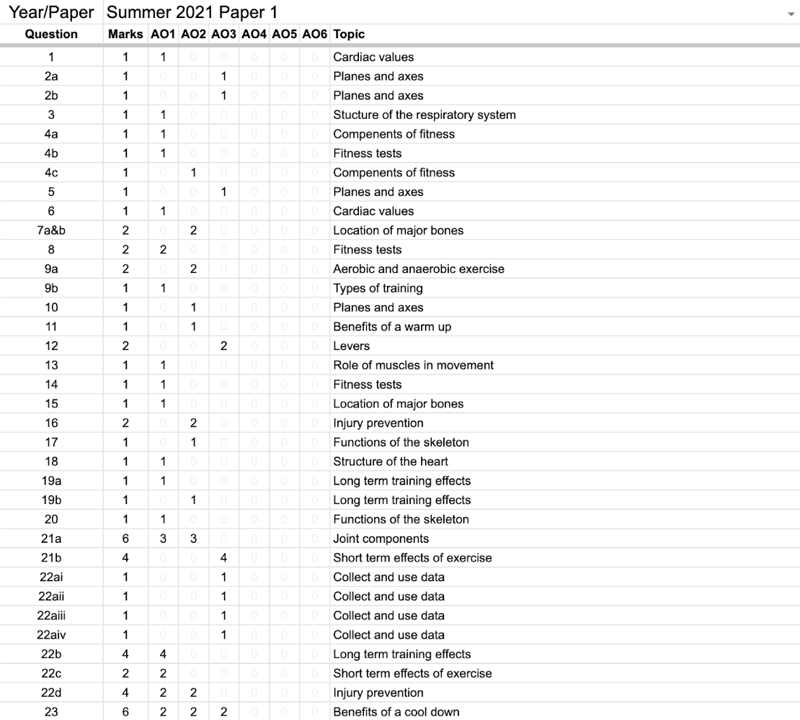
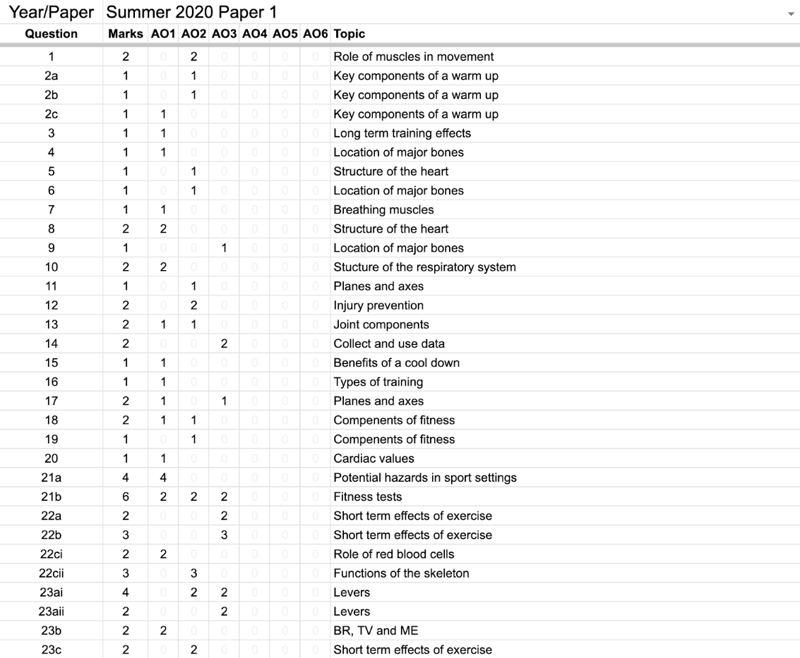
On each occasion in the past three years (and before), question 21 has seen an increase in the mark tally of each question but also a relative increase in the proportion of marks coming from higher skills such as AO2 and AO3. Therefore, I recommend the following:
- The invigilator states “You may open your papers.”
- Turn paper immediately to question 21.
- Read through questions 21 to 23 and make notes on spare paper you have already requested from the front.
- Once you have read through these questions, return to question 1 and commence your answering.
- When you arrive at question 21, return to your notes to support you.
Now, this is entirely optional but, in my opinion, high-performing students on this paper will follow this outline. The processing time between when you read questions 21 to 23 and eventually answer them is valuable, in my opinion. Others will prefer a different structure but this is a broad recommendation.
Finally, I strongly recommend that you ask for extra paper before the exam starts. You can use that paper to make notes and plan answers or scribble down keywords. I like the idea that every GCSE PE student will start their Paper 1 exam by asking the invigilator for paper before the exam itself begins. Let’s see a sea of raised PE arms in May!
Top Tip #7 Be aware of the Paper 2 topics that have appeared on Paper 1 in the past.
As you will likely know, OCR GCSE PE six-mark, levelled questions require you to have knowledge of topics from both Paper 1 and Paper 2 for both papers. For example, on Paper 1 in May, you will receive a six-mark question that requires you to provide writing on both a Paper 1 and a Paper 2 topic.
Knowing which Paper 2 topics have been included on Paper 1 in the past is helpful. Take a look at this table:
|
Paper |
Six-mark Paper 1 topic |
Six-mark Paper 2 topic |
|
2018 |
Components of a warm-up |
Mental preparation |
|
2019 |
Principles of training |
Drugs in sport |
|
2020 |
Fitness tests |
Types of feedback |
|
2021 |
Benefits of a cool-down |
Mental preparation |
|
2022 |
Types of training |
Factors affecting participation |
|
*2023 National Mock Exam |
Benefits of a cool-down |
Hydration |
*Written by The EverLearner Ltd NOT OCR.
Do you identify any patterns? Can we predict anything?
Well, there are certainly patterns. This is what I recognise:
- Every Paper 1 topic has been derived from the 1.2 Physical Training section of the course.
- Three of the five Paper 2 topics have come from Sport Psychology.
Now, nobody can predict your exam paper. Anyone trying to do that should be ignored. However, all of the following statements are fair:
- High-performing students will be capable of writing six-mark answers from the 1.2 Physical Training section.
- High-performing students will have an excellent knowledge of the 2.2 Sports Psychology section of Paper 2 in preparation for the Paper 1 exam.
Please note: I am absolutely not suggesting that anyone only prepares these sections. This would be very foolish. I am encouraging you to over-practise and over-learn these sections in preparation for a potential six-marker.
Top Tip #8 Complete and mark the National Mock Exam.
As I think you can probably tell, I think quite a lot about how to perform well on OCR GCSE PE Paper 1. All of my thinking has been put into writing a highly relevant National Mock Exam paper which I published in January 2023. I urge you to speak to your teacher and ask them to download this paper and mark scheme, and to give you the opportunity to answer it, ideally under assessment conditions, before marking it using the mark scheme.
There is quite literally no better preparation for your exam that you can do.
Top Tip #9 Learn my model answers.
On April 28th, I’ll be publishing my model answers to the National Mock Exam for everyone to download and read. I am going to make a very fundamental point about them here: LEARN THE MODEL ANSWERS. I mean, really now, please learn them. The model answers are hyper-relevant to your exam experience this summer and represent the ideal ways to answer all kinds of questions including the skills discussed in many of the points above.
Please, please, please, learn those answers. You will not regret one second of doing so.
Top Tip #10 Attend my revision sessions in May.
And finally… a very, very simple message: I will be broadcasting my Live Revision show based on all the points made above on Thursday 4th May, two weeks before your exam on the 17th.
Folks, I cannot make this clearer: Be there! Whilst I can’t promise you entertainment like Netflix or giggles like going out with your mates, I can guarantee you that this session is delivered with everything I am and will help you massively in your preparations for the exam itself. The revision is utterly free and comes with an entire notes pack as well as the previously published infographics, mock exam, mark scheme and model answers.
BE THERE!!!
Thank you for reading and have a wonderful day.
%20Text%20(Violet).png)

